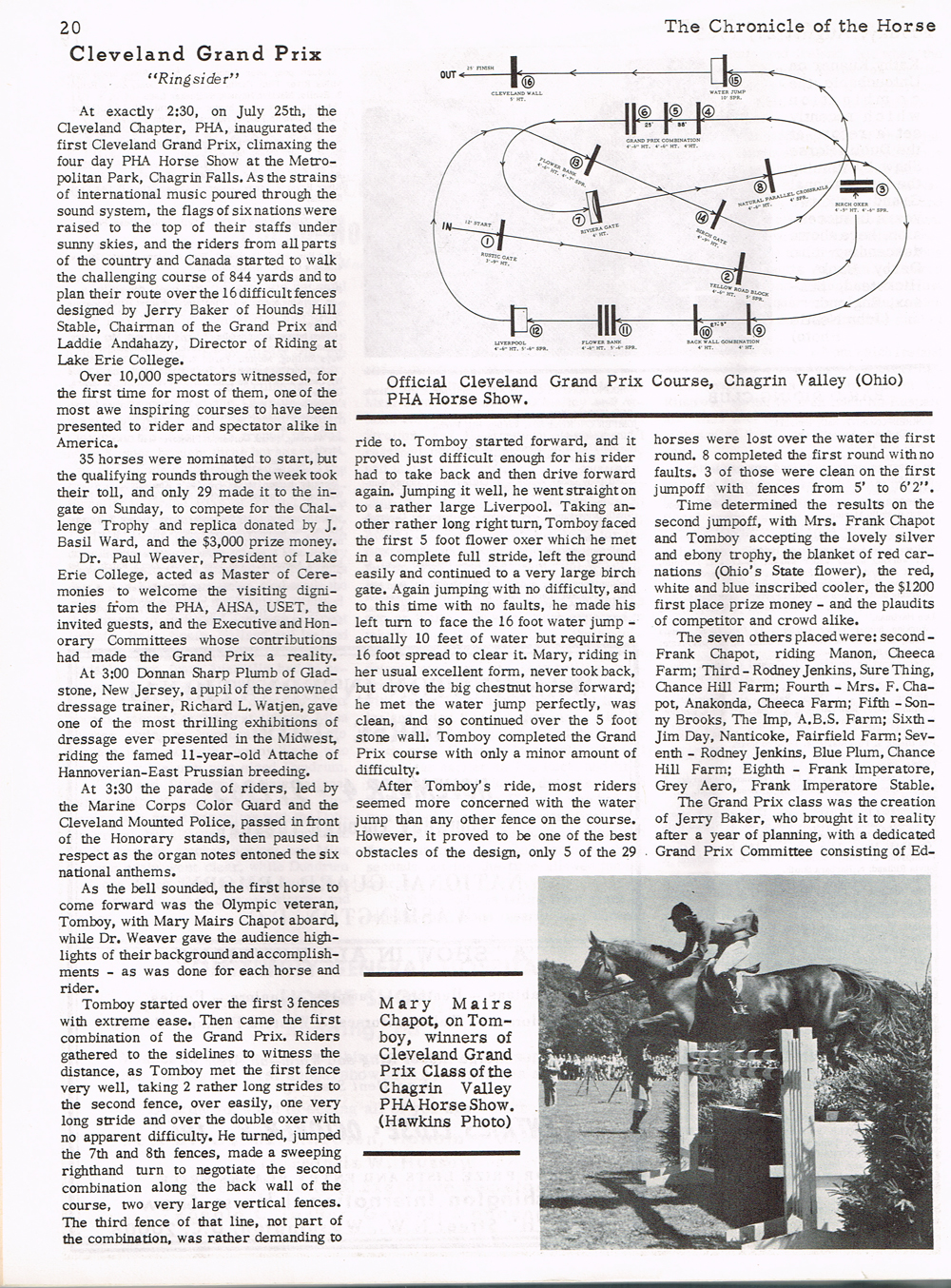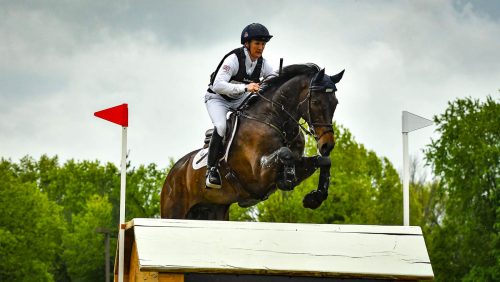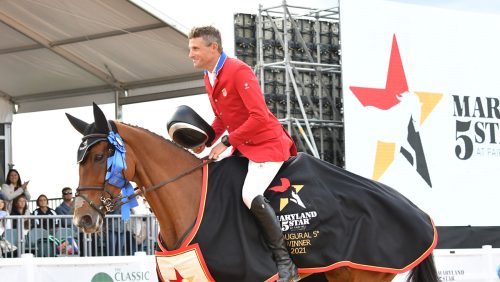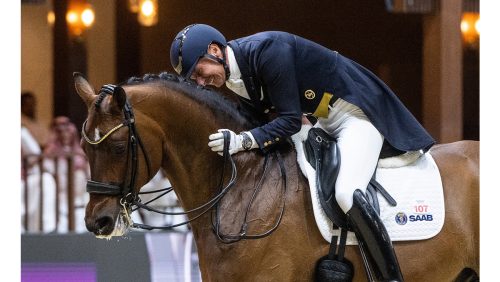In the Aug. 27, 1965, edition of The Chronicle of the Horse appeared an article about the very first show jumping grand prix to be put on in the United States. The class was held in Cleveland, Ohio, on July 25 as part of the PHA Horse Show. Here’s the entire text of that article, and scroll down to see scans of the actual pages of the article in that issue of the Chronicle.
At exactly 2:30, on July 25th, the Cleveland Chapter PHA inaugurated the first Cleveland Grand Prix, climaxing the four-day PHA Horse Show at the Metropolitan Park, Chagrin Falls. As the strains of international music poured through the sound system, the flags of six nations were raised to the top of their staffs under sunny skies, and the riders from all parts of the country and Canada started to walk the challenging course of 844 yards and to plan their route over the 16 difficult fences designed by Jerry Baker of Hounds Hill Stable, Chairman of the Grand Prix and Laddie Andahazy, Director of Riding at Lake Erie College.
Over 10,000 spectators witnessed, for the first time for most of them, one of the most awe inspiring courses to have been presented to rider and spectator alike in America.
35 horses were nominated to start, but the qualifying rounds through the week took their toll, and only 29 made it to the in-gate on Sunday to compete for the Challenge Trophy and replica donated by J. Basil Ward, and the $3,000 prize money.
Dr. Paul Weaver, President of Lake Erie College, acted as Master of Ceremonies to welcome the visiting dignitaries from the PHA, ASHA, USET, the invited guests and the Executive and Honorary Committees whose contributions had made the Grand Prix a reality.
At 3:00, Donnan Sharp Plumb of Gladstone, New Jersey, a pupil of the renowned dressage trainer Richard L. Watjen, gave one of the most thrilling exhibitions of dressage ever presented in the Midwest, riding the famed 11-year-old Attache of Hannoverian-East Prussian breeding.
At 3:30 the parade of riders, led by the Marine Corps Color Guard and the Cleveland Mounted Police, passed in front of the Honorary stands, then paused in respect as the organ notes entoned the six national anthems.
ADVERTISEMENT
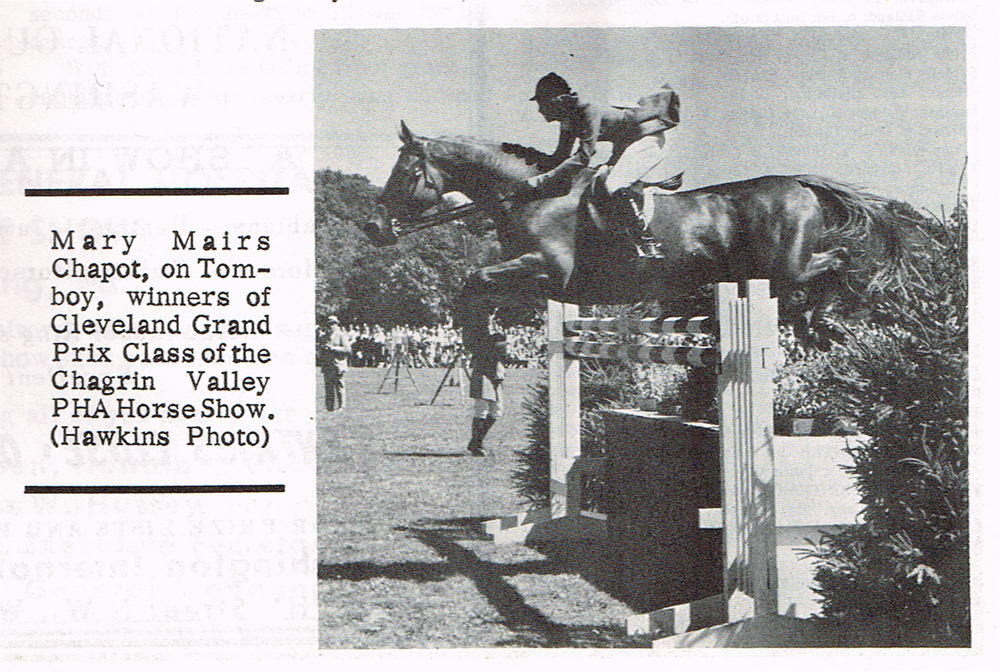 As the bell sounded, the first horse to come forward was the Olympic veteran, Tomboy, with Mary Mairs Chapot aboard, while Dr. Weaver gave the audience highlights of their background and accomplishments—as was done for each horse and rider.
As the bell sounded, the first horse to come forward was the Olympic veteran, Tomboy, with Mary Mairs Chapot aboard, while Dr. Weaver gave the audience highlights of their background and accomplishments—as was done for each horse and rider.
Tomboy started over the first 3 fences with extreme ease. Then came the first combination of the Grand Prix. Riders gathered to the sidelines to witness the distance, as Tomboy met the first fence very well, taking 2 rather long strides to the second fence, over easily, one very long stride and over the double oxer with no apparent difficulty. She turned, jumped the 7th and 8th fences, made a sweeping righthand turn to negotiate the second combination along the back wall of the course, two very large vertical fences. The third fence of that line, not part of the combination, was rather demanding to ride to.
Tomboy started forward, and it proved just difficult enough for her rider had to take back and then drive forward again. Jumping it well, she went straight on to a rather large Liverpool. Taking another rather long right turn, Tomboy faced the first 5-foot flower oxer which she met in a complete full stride, left the ground easily, and continued to a very large birch gate.
Again jumping with no difficulty, and to this time with no faults, she made a left turn to face the 16-foot water jump—actually 10 feet of water but requiring a 16-foot spread to clear it. Mary, riding in her usual excellent form, never took back, but drove the big chestnut forward; she met the water jump perfectly, was clean, and so continued over the 5-foot stone wall. Tomboy completed the Grand Prix course with only a minor amount of difficulty.
After Tomboy’s ride, most riders seemed more concerned with the water jump than any other fence on course. However, it proved to be one of the best obstacles of the design, only 5 of the 29 horses were lost over the water the first round. 8 completed the first round with no faults. 3 of those were clean on the first jump-off with fences from 5’ to 6’2”.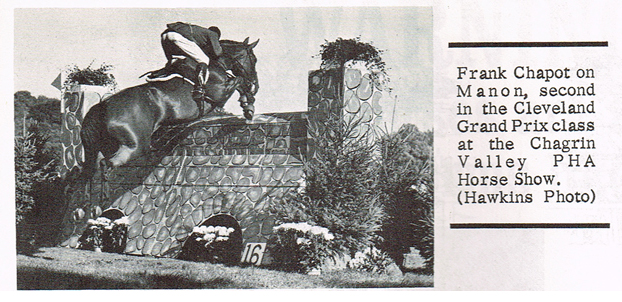
Time determined the results on the second jump-off, with Mrs. Frank Chapot and Tomboy accepting the lovely silver and ebony trophy, the blanket of red carnations (Ohio’s state flower), the red, white and blue inscribed cooler, the $1,200 first place prize money—and the plaudits of competitor and crowd alike.
The other seven riders placed were: second—Frank Chapot, riding Manon, Cheeca Farm; Third—Rodney Jenkins, Sure Thing, Chance Hill Farm; Fourth—Mrs. F. Chapot, Anakonda, Cheeca Farm; Fifth—Sonny Brooks, The Imp, ABS Farm; Sixth—Jim Day, Nanticoke, Fairfield Farm; Seventh—Rodney Jenkins, Blue Plum, Chance Hill Farm; Eighth—Frank Imperatore, Grey Aero, Frank Imperatore Stable.
ADVERTISEMENT
The Grand Prix class was the creation of Jerry Baker, who brought it to reality after a year of planning, with a dedicated Grand Prix committee consisting of Edward T. Clark, Raymond M. Francis, Herbert R. Lilley, Charles E. Mapes, PHA Chairman, Jerome W. Rogers, Donald L. Snellings, and Mrs. Esther L. Voorhees.
Only one accident, Michigander Max Bonham’s fall, marred the proceedings, but after a precautionary hospital check, he reappeared to watch the conclusion. A salute was also given to Sonny Brooks of New Jersey, who had bailed off from a falling horse in a qualifying class, completed a qualifying round of a second horse with an arm broken above the wrist before going to the hospital, and rode the last two days of the show and in the Grand Prix with his arm in a cast.
With the last ribbon and championship awarded and the last horse in his stall, all those having a part in the production of the Cleveland Grand Prix adjourned to Hunting Hill, home of Mr. and Mrs. Gilbert Humphrey, for a leisurely social hour before homeward treks began.
